Gender & Sexuality
1/32
Earn XP
Description and Tags
Why were they so preoccupied w/these issues? How coherent were their ideas? Misogyny? How did they apply their basic ideas to real social & practical problems? Impact of their ideas?
Name | Mastery | Learn | Test | Matching | Spaced |
|---|
No study sessions yet.
33 Terms
What did learned 👨 have to say ab. gender, ⚭ & sex?
institutional developm. met w/intellectual developm.
(C12 & C13) Huge growth in institutions learning
(C12) ↑ no. 🏫s focused on cathedrals/ indiv. 👨🏫
(end C12) Earliest unis emerged Paris Bologna; ↑ est. C13
→ developm. theology & canon law in their own faculties
→ ♂ intellectual elite
What did learned 👨 have to say ab. gender, ⚭ & sex?
nature 👨 & 👩
Eve
Medieval burdened w/legacy Eve, consid. responsible for Fall & lead. 👨 astray
Eustache Deschamps’ 📚Miroir de Mariage
Stereotypes: 👩 inferior to & morally weaker than 👨 + ↑ prone to deception, temptation & obed.
Jacques de Vitry (theologian, chronicler, leading churchman, died 1240)
'Between A and God in Paradise there was but 1 👩, and she had no rest until she had succeeded in banishing her 🤵 ← the gardens of delight and in condemning Christ to the torment of the Cross.'
👩 as daughters of Eve/ Eve as archetypal 👩
(Robert d’Abrissel) a woman is a witch, a snake, a plague, a rat, a rash, a poison, a burning flame & an assistant of the Devil’
Beyond Eve and Mary Premodern Representations of Gender, Power, and Religion - Issuu
What did learned 👨 have to say ab. gender, ⚭ & sex?
nature 👨 & 👩
Aristotle
Highly influential on Western thought; seemingly supp. by contemporary ‘science’ of Aristotle’s day → added biological aspect.
empiricist
Drew his conclusions ← observation: by observing way 👩 in his soc. behaved, decided what was ‘nat.’
Preformationist
Reprodution occurs due to 👨 ability to prod. semen (prod. homunculus).
Know ab. female ability to prod. 🥚s; 👩 merely incubator.
→ on rec. end life-giv. force prod. by 👨
Observed 👩 able to prod. semen → equivalent to fertile 👨: ‘defective’.
👨 active in reprod.; 👩 passive.
👩 nat. ferior to men → right that 👨 should govern 👩, just as 🧍🐱s governed by 🧍s.
quotes
more mischievous, less simple, more impulsive [...] more compassionate [...] more easily moved to tears [...] more jealous, more querulous, more apt to scold and to strike [...] more prone to despondency and less hopeful [...] more void of shame or self-respect, more false of speech, more deceptive, of more retentive memory [...] also more wakeful; more shrinking. more difficult to rouse to action
Aristotle, c. 400BC, 608b, 1-14
It is the best for all tame animals to be ruled by human beings. For this is how they are kept alive. In the same way, the relationship between the male and the female is by nature such that the male is higher, the female lower, that the male rules and the female is ruled.
Aristotle, Politica, 1254b 10-14
What did learned 👨 have to say ab. gender, ⚭ & sex?
nature 👨 & 👩
Aristotle’s influence on Western thought
followed ← this that 👩 ferior & subject to 👨
When 👩 ⚭…
Law of coverture: wealth → husband.
Held same legal status as husband’s pets.
‘to obey’ husband
Albert the Great (C13 Dominican)
Woman is less qualified [than man] for moral behaviour. For the woman contains more liquid than the man, and it is a property of liquid to take things up easily and to hold onto them poorly. Liquid's are easily moved, hence women are inconstant and curious. When a woman has relations with a man, she would like, as much as possible, to be lying with another man at the same time. Woman knows nothing of fidelity. Believe me, if you give her your trust, you will be disappointed. Trust an experienced teacher. For this reason prudent men share their plans and actions least of all with their wives. Woman is a misbegotten man and has a faulty and defective nature in comparison with his. Therefore she is unsure in herself. What she herself cannot get, she seeks to obtain through lying and diabolical deception. And so, to put it briefly, one must be on one's guard with every woman, as if she were a poisonous snake and the horned devil.'
Thomas Aquinas (C13 Dominican)
Also used word ‘fective’ 👩 when comparing them to 👨.
Feriorto 👨 in physical strength & intellig.god created 👩 to be
feriorto 👨 as part. nat. variety & order 🌍; they have alw. been that way,just result Eve’s sinGod made 👩 to be subordinate to 👨 - nat. & right that 👨 should have auth. over 👩 in everyth.
'With respect to her particular nature, woman is deficient and misbegotten... However, with respect to nature in general, a woman is not something misbegotten but intended by nature to be directed to the work of procreation.'
'It was necessary for woman to be made... as a "helpmate" to man - not to help him in ... work ... since he can get more effective help from another man, but as a helpmate in procreation.'
'Man however is directed towards a ... nobler ... activity, which is knowledge'.
female subjection
'the woman needs the man not only for generating and educating the children, but also as her personal master' for the man is of 'more perfect reason' and 'stronger virtue'.
Goodman of Paris
Copy the behaviour of a dog which loves to obey its master; even if the master whips it, the dog follows, wagging its tail.
📚 Treatise The Goodman of Paris - 👩 should emulate behaviour 🤵’s lap🐶, being meek & obed. to 👨 who provides her w/🍔 & shelter, even if he maltreats her.
What did learned 👨 have to say ab. gender, ⚭ & sex?
nature 👨 & 👩
VM
(← 2nd 1/2 C11) new interest.
Some took her as ideal/model for women: chaste, silent & obed.
Peter Abelard.
Special high place in heaven for women (e.g. VM) & women who waited @ foot cross when JC crucified
Commended them for their love of God.
Most emphasized her singularity → could help.
But
dignifyordinary 👩 (except case nuns)
Remaining chaste in proc. birth emphasises to modern reader the poss. nature of this ideal.
A prayer: 'Virgin Mary, holy and immaculate bearer of God, most kind, most merciful and most holy, glorious mother of my Lord and illustrious beyond the stars, you who alone without equal have been a woman pleasing to Christ, ... come to the aid of a miserable sinner...' [my emphasis]-
What did learned 👨 have to say ab. gender, ⚭ & sex?
purpose ⚭
Sex closely regulated by medieval Church.
Attitudes to ⚭ influenced by St Paul’s teaching & laws created by RCC to regulate sexual conduct.
His teachings advocated ⚭ as means legitimating sex & belittling lust by ⚭ing it to hell:
“It is better to ⚭ than to burn” (1 Corinthians 7:9)
→
sex gen. bad
concept celibacy & virginity as higher states of spiritual purity & dedication to God was prevalent in medieval Christianity, particularly among clergy and religious orders.
see essay
However, this ideal of celibacy was distinct from the institution of marriage, and the expectation for sexual abstinence was primarily directed at those who chose to embrace a celibate or monastic life rather than married individuals.
But allowed if…
concession to weakn. flesh, permissable as remedy for sin lust
prov. lawful outlet for sex, thereby mitigating pot. for sin outside ⚭
for those too weak to resist temptation
feriorway of life (see celibacy notes)
Sex allowed/sinless if…
within ⚭
using missionary position (reflects nat. superiority 👨 over 👩)
for purpose procreation
also focus on fulfilling marital duties (pay St Paul’s marital debt) - see later fc
Some scholars even advocated sexless ⚭ (pictured)
Never seen as contradictory; disputes

What did learned 👨 have to say ab. gender, ⚭ & sex?
purpose ⚭ → more positive
Concern w/spiritual role ⚭ → more positive view it → discussion marital affection
Medieval theologians & moralists reconciled contradiction within framework ⚭ as sacrament & divine institution ordained by God.
→ discussion companionship & 💘 in ⚭ + marital debt (see later fc)
→ sex within ⚭ both procreative & unitive, intended for mutual supp. & fulfillm. (fulfil marital bond)
finish this one later
The perception of chastity in medieval Christian thought did indeed hold an elevated status, particularly within the context of religious devotion and spiritual purity. Chastity was often idealized as a virtue, especially for those who chose a celibate or monastic life dedicated to religious service. However, within the institution of marriage, the expectation was typically for sexual relations to occur between spouses, as it was considered both a natural and necessary aspect of the marital bond.
While there may appear to be a contradiction between the exaltation of chastity and the expectation of sexual activity within marriage, medieval theologians and moralists reconciled these concepts within the framework of marriage as a sacrament and a divine institution ordained by God.
In medieval Christian theology, marriage was viewed as a holy union blessed by God, intended for companionship, procreation, and mutual support between spouses. Sexual relations within marriage were seen as a legitimate expression of marital love and fidelity, sanctioned by God for the propagation of the human race and the strengthening of the marital bond.
Additionally, while chastity was indeed praised as a virtue, it was not necessarily expected or required of all individuals, especially those who chose the vocation of marriage. Instead, chastity was often understood as a calling for those who embraced celibacy or vowed religious life, such as monks, nuns, and clergy, rather than a universal expectation for all members of society.
Therefore, while there may be a tension between the ideals of chastity and the realities of sexual activity within marriage, medieval Christian thought generally accommodated both concepts within the broader framework of moral and theological teachings on marriage and sexuality.
Certainly! While medieval scholars did not explicitly address the apparent contradiction between the exaltation of chastity and the expectation of sexual activity within marriage in the same terms as contemporary discourse, their writings and theological teachings provide insights into the medieval understanding of these concepts within the context of marriage. Here are a few medieval scholars and theologians whose works shed light on this topic:
1. Thomas Aquinas (1225-1274): Aquinas, a Dominican friar and theologian, wrote extensively on moral theology and natural law. In his "Summa Theologica," Aquinas discusses the sacrament of marriage and the moral legitimacy of sexual relations within marriage. He emphasizes the importance of marital love, fidelity, and procreation within the bounds of marriage, framing sexual relations as a natural and lawful expression of spousal unity.
2. Peter Lombard (c. 1100-1160): Lombard, a theologian and bishop of Paris, authored the influential theological text "Sentences." In his writings, Lombard addresses the sacrament of marriage and its significance within Christian theology. While he upholds the virtue of chastity, Lombard also acknowledges the licitness of sexual relations within marriage as ordained by God for the propagation of the human race and the fulfillment of marital duties.
3. Hildegard of Bingen (1098-1179): Hildegard, a German Benedictine abbess, mystic, and theologian, wrote prolifically on theological and spiritual matters. In her works, including "Scivias" and "Symphonia," Hildegard explores themes of divine love, marriage, and the spiritual significance of sexuality within the context of God's creation. While she extols the virtues of chastity and spiritual purity, Hildegard also acknowledges the sanctity of marriage and the goodness of sexual relations within the marital union.
4. Bernard of Clairvaux (1090-1153): Bernard, a French abbot and theologian, was a prominent figure in medieval mysticism and monastic reform. In his sermons and letters, Bernard emphasizes the importance of marital fidelity and mutual love within the institution of marriage. While he upholds the value of chastity for those called to celibate vocations, Bernard also recognizes the God-given nature of marital intimacy and the responsibilities of spouses towards one another.
These scholars, among others, contributed to the medieval understanding of marriage, chastity, and sexuality within the framework of Christian theology and moral teachings. While they may not have directly addressed the apparent contradiction between chastity and sexual activity within marriage, their writings offer insights into the medieval perspective on these complex theological and ethical issues.
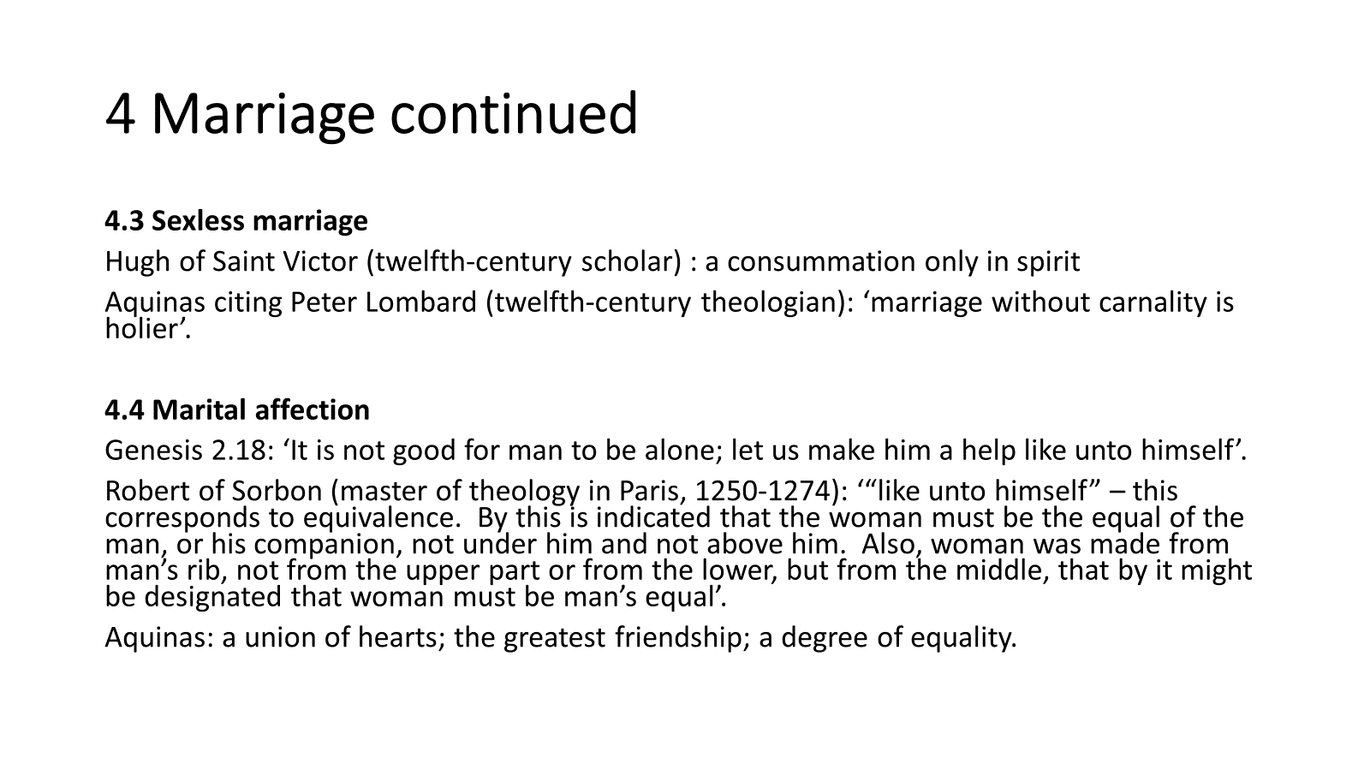
What did learned 👨 have to say ab. gender, ⚭ & sex?
constitution: when did ⚭ → fully est?
BUT were big disputes ab. what is meant to define a ⚭
when couple had sex?
when consented to ⚭?
Mattered in both theory…
If ⚭ had to be consummated to be valid, M & J’s ⚭ embarrassment
& practice…
⛪ had to settle ⚭ disputes in ⛪ courts
Could couples sep. if their ⚭ had
yet been consummated?
(late c12) Issue ‘settled’ by compromise
Pope Alexander III backed
Free consent req. (⚭ valid ← consent to ⚭ but could be annulled until consummated)
continued issue w/constitution after compromise
issue = arranged ⚭s politically advantageous → individual’s consent
come into itidea consent est. valid ⚭ went along w/idea perfect ⚭ should be modelled on marriage joseph & mary: should be sexless/ chaste
Aquinas: get quote ← slide
can this be the misogynist Aquinas quoted earlier?
when intellectuals talk ab. marital affection, contradicted what they said elsewhere → came up w/much more postiive views women
women deceitful yet marriage should be equal
→ don’t simplistically present them as misogynists
What did learned 👨 have to say ab. gender, ⚭ & sex?
sex: marital debt
St Paul created concept marital debt, which encouraged both 🤵 & 👰 to have sex when requested by their spouse:
“For the wife does not rule over her own body, but the husband does; likewise the husband does not rule over his own body, but the wife does” (1 Corinthians 7: 3–5)
Each spouse had moral obligation to keep other sexually satisfied, lest s/he be tempted elsewhere.
Debt enforceable @ law.
Entry to religion req. your spouse’ agreem. to forego debt.
Wife impotent husband could get their marriage annulled because her husband
capablepaying debt.
can probably get more reading for this
What did learned 👨 have to say ab. gender, ⚭ & sex?
sex
positions
times
missionary only way acceptable
woman on top = inversion nat. order that demanded male dominance
← behind = animal way
not at Lent, Advent, feast days…
when wife menstruating/ pregnant (check A-Level notes)
as long as had sex in proper way at right time in order to have children/ fulfil debt, surely you’re ok… though not all theologians agreed
not at Lent, Advent, feast days…
when wife menstruating/ pregnant (check A-Level notes)
as long as had sex in proper way at right time in order to have children/ fulfil debt, surely you’re ok… though not all theologians agreed
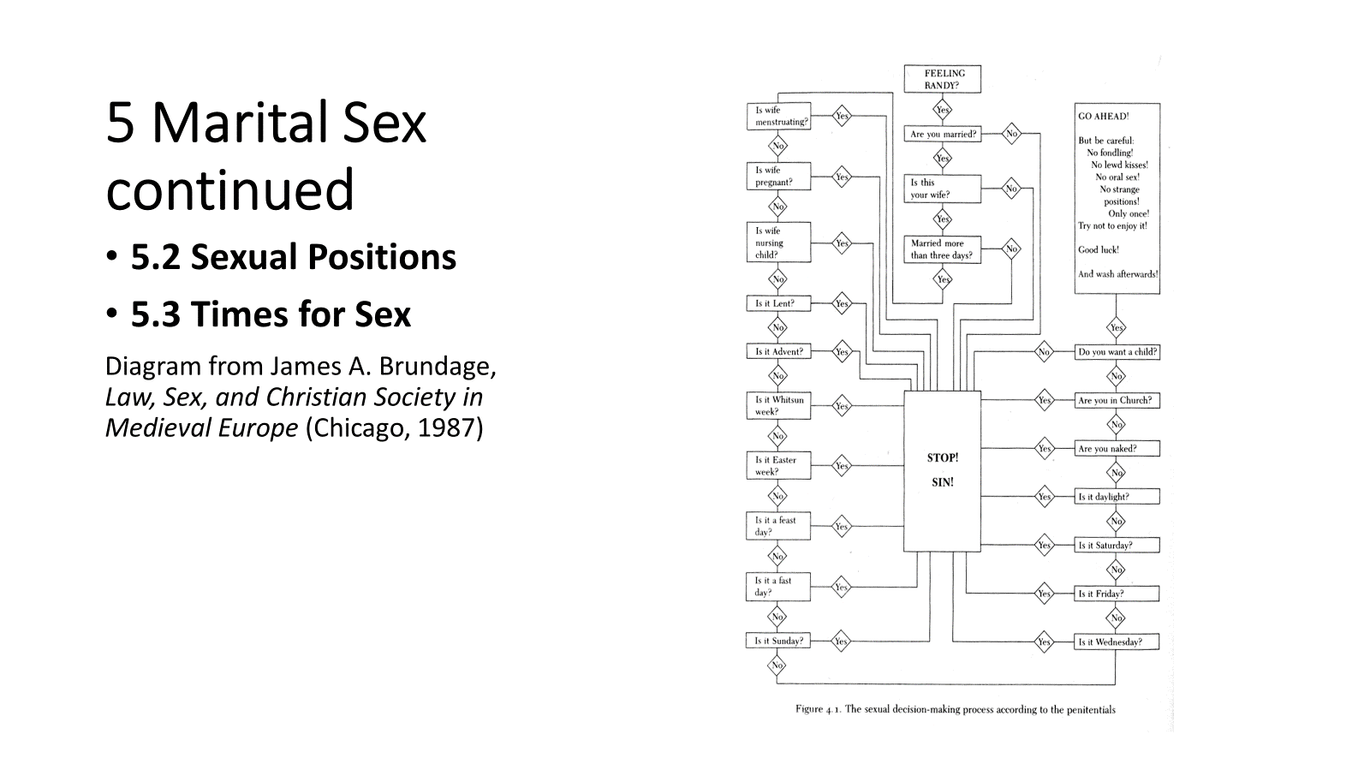
What did learned 👨 have to say ab. gender, ⚭ & sex?
sex
pleasure
Sexual pleasure complicates things… debate morality it
Some said pursuit sexual pleasure sinful.
Some argued all sexual pleasure inherently wrong, even win bounds procreating/ fulfiling partner’s lust (sought)
→ all sex sinful (pleasure inevitable since part of ejaculation)
women @ fault since women believed topossess ‘seed’, contrib. to pot. for pleasure →
hence, women seen as equally culpable for sinful nature sex
Issue: sinful to ask for sex but you were obliged to offer it
Albert the Great
'The spouse who demands acts out of lustful desire, the spouse that does his duty acts on the basis of the virtue of marital fidelity. Thus the demand is sin, and the fulfillment of duty is merit.'
Pope Innocent III
'Who could not know that the consummation of marriage never takes place without the flames of lasciviousness, without the pollution of lust.'
Huguccio (lawyer, d. 1210)
'I can do my duty to my wife and wait until she has fulfilled her pleasure. In fact, in such cases women are often accustomed to feel the pleasure before their husbands, and when the woman's pleasure in the physical act has been sated, I can, as I wish, withdraw without fulfilling my pleasure, free from sin and without letting the seed of generation flow forth.'
Solution = coitus reservatus
Man should wait for wife to have orgasm then withdraw from her, being careful not to ejaculate → careful
to exper. pleasurewife's pleasure was seen as a natural and inevitable aspect of sexual intercourse, and her orgasm was considered less sinful than the husband's. Therefore, by waiting for the wife to experience pleasure first, the husband could then withdraw without experiencing sinful pleasure himself. This perspective aimed to reconcile the fulfillment of marital duties with concerns about the sinful nature of sexual pleasure.
Resolve issue
diff. views pleasure & sinfulness sex, which were never resolved
but everyone recogn. was a problem w/sexual pleasure, nobody defended it as such… right? NOT
What did learned 👨 have to say ab. gender, ⚭ & sex?
sex
dissenting views on pleasure
Peter Abelard (😵 1142)
'they say that marital intercourse and the eating of delicious food are in fact conceded in such a way that the pleasure itself is not conceded; they should be performed wholly without pleasure. But assuredly if this is so, they are allowed to be done in a way in which they cannot be done at all and it was an unreasonable permission which allowed them to be done in a way in which it is certain that they cannot be done.'
It is clear... that no natural pleasure of the flesh should be imputed to sin, nor should it be considered a fault for us to have pleasure in something in which... the feeling of pleasure is unavoidable.'
Leading scholar W.Europe late C12
📖 Ethics (moral status of an act depended on intention act lay behind it; not just what you do but what you meant to do → context discussed sexual pleasure)
if husband & wife must have sex which involved pleasure, why would God make pleasure sinful?
→ dismissed idea marital sex only permissable in an impossible fashion
that pleasure cannot be sinful since inevitable
But he still claimed ideal motive for marital sex was desire to have a child → not arguing for pursuit pleasure for its own sake
still thought celibacy more perfect & meritorious than marriage, which was way to avoid fornication
also he was a lone voice - no other theologian/ lawyer took up his argum. for naturalness pleasure
nevertheless, was 1 scholar who refused to condemn couples for feeling pleasure in sex & he was v/famous → diff. outlook poss.
wriintg earlier, pre-insttutionalisation
What did learned 👨 have to say ab. gender, ⚭ & sex?
concern ab. moral problems for women
giving alms
knowl. paternity
killing attacker to avoid being raped
Not indifferent to moral problems their values created for women; the salvation of women mattered
very concerned ab. moral problems faced by women
clear ← disputation in Uni Paris (check name; anyone in aud. could ask anything)
many questions ab. marriage issues & problems faced by women in the marriage
e.g. ab. problems ← wife’s subjection to her husband
can woman give alms w/o her husband’s consent ← goods held by him? answer was no
what ab. wife of a userer? can she eat? if doesn’t die, but if does, party to usury? depended on freedom she enjoyed in practice in her marriage. if indep. ← husband, should ensure doesn’t go to usury but if not, killing herself would be worse sin
knowl. paternity
women shoudl do everyth. poss. to prevent marriage bet. two enemies’ children she had both had (half-siblings) but if that fails, should reveal
killing rapist
no, her sin in killing would be greater than his sin in raping
however diff. their values, lawyers not indiff. to women’s needs
salvation women → heaven mattered to him
important nuance
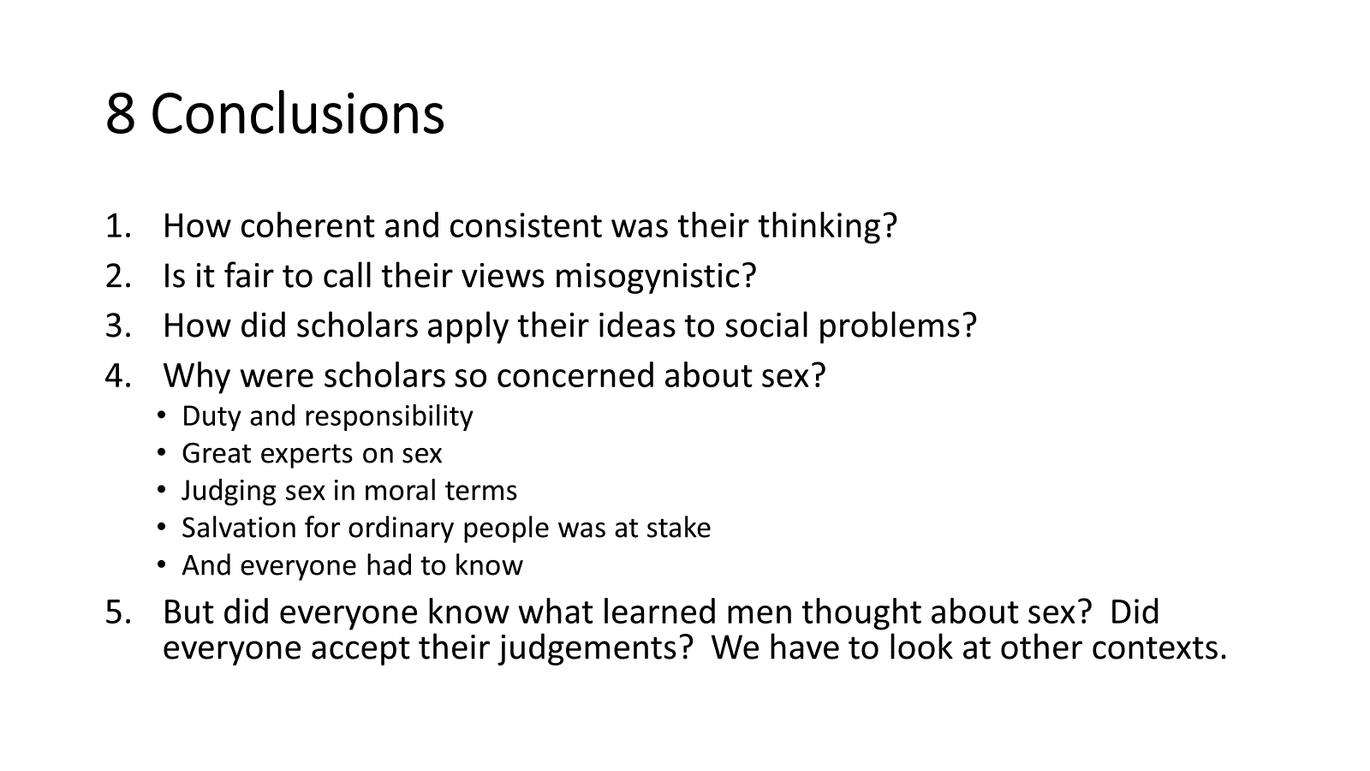
all agreed ab. what sexual posititons allowed, purpose sex… but not so consistent w/themselves, espec. so w/nature women
temptress, vicivious… but when talked ab. marital affection, talked ab. equality (Aquinas)
also contradicted each other: partic. in regards to est. marriage, sexual pleasure & sin…
→ overall picture not coherent & consistent
oversimplification
cared ab. moral problem’s women faced
rape could enhance women’s indep.
wiht great care & in great detail
other values somet. emerged in the proc.
their duty & responsibility (great experts on sex even though celibate (21stC)
not because claimed direct exper. but because knew how to judge sex in moral terms
matter salvation for ordinary people → theologians & lawyers morally obliged to find out & investigate where sin involed + their duty to ensure everyone knew how to attain salvation (what they could & couldn’t do)
Were people outside the schools & unis familiar w/the views of learned men on sex & marriage?
RCC ensured everyone aware ideas & values developed by clerical intellectuals.
🧍aware of scholars’ thinking @ least in simplified form (basic messages).
Were people outside the schools & unis familiar w/the views of learned men on sex & marriage?
How were the views of learned men communicated?
preaching
Many sermons specifically aimed at married couples
hostility to lust witin marriage
marital affection
procreative function marrigae
this type sermon very common
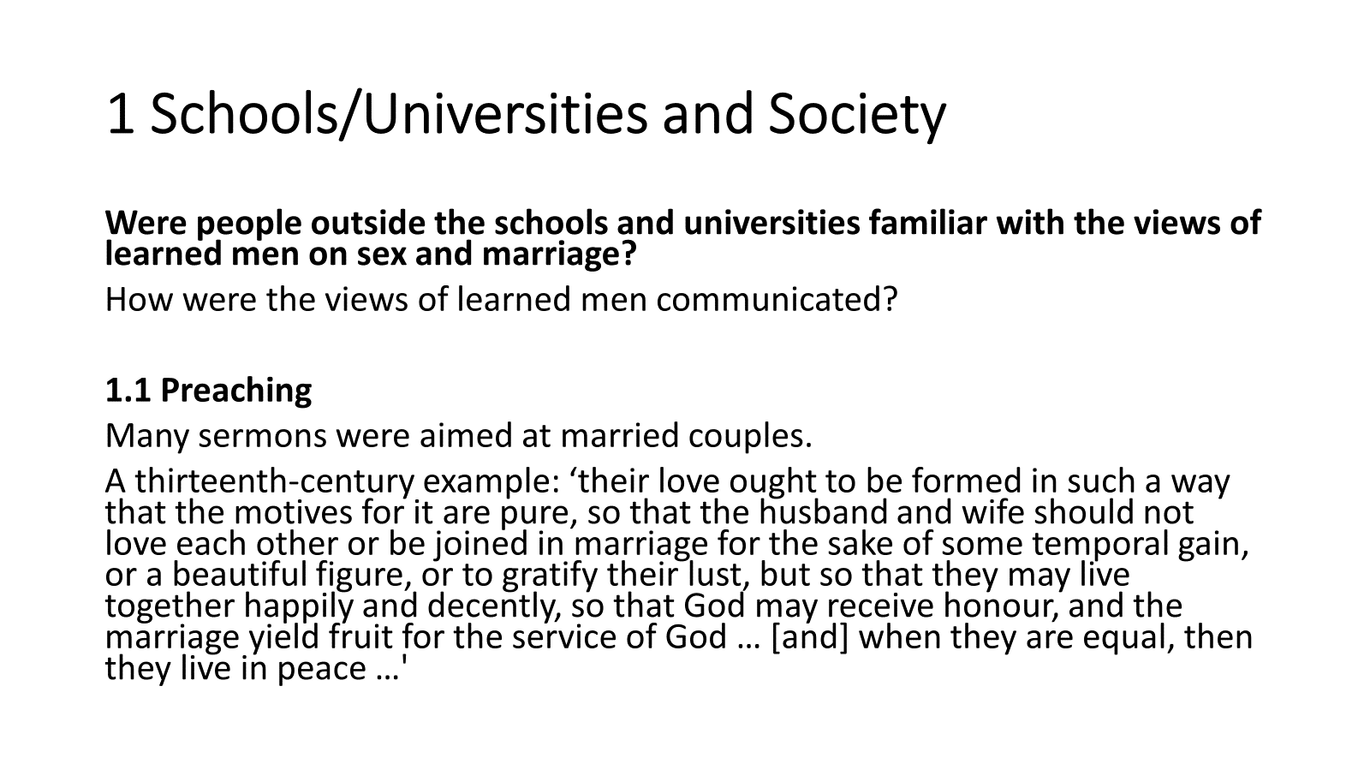
Were people outside the schools & unis familiar w/the views of learned men on sex & marriage?
How were the views of learned men communicated?
church courts
confession
when couples tried to sep. → given judgement
1215: annual confession to parish priest → compulsory
here where ideals perfect sexual activity enforced
idea was for priest to regulate sex, not give info that would lead people to sin (hence couldn’t say have you done this, giving people ideas)
C13 guide for confessors said priest should explain the sin against nature as follows…
had to find out what was going on really uneasily
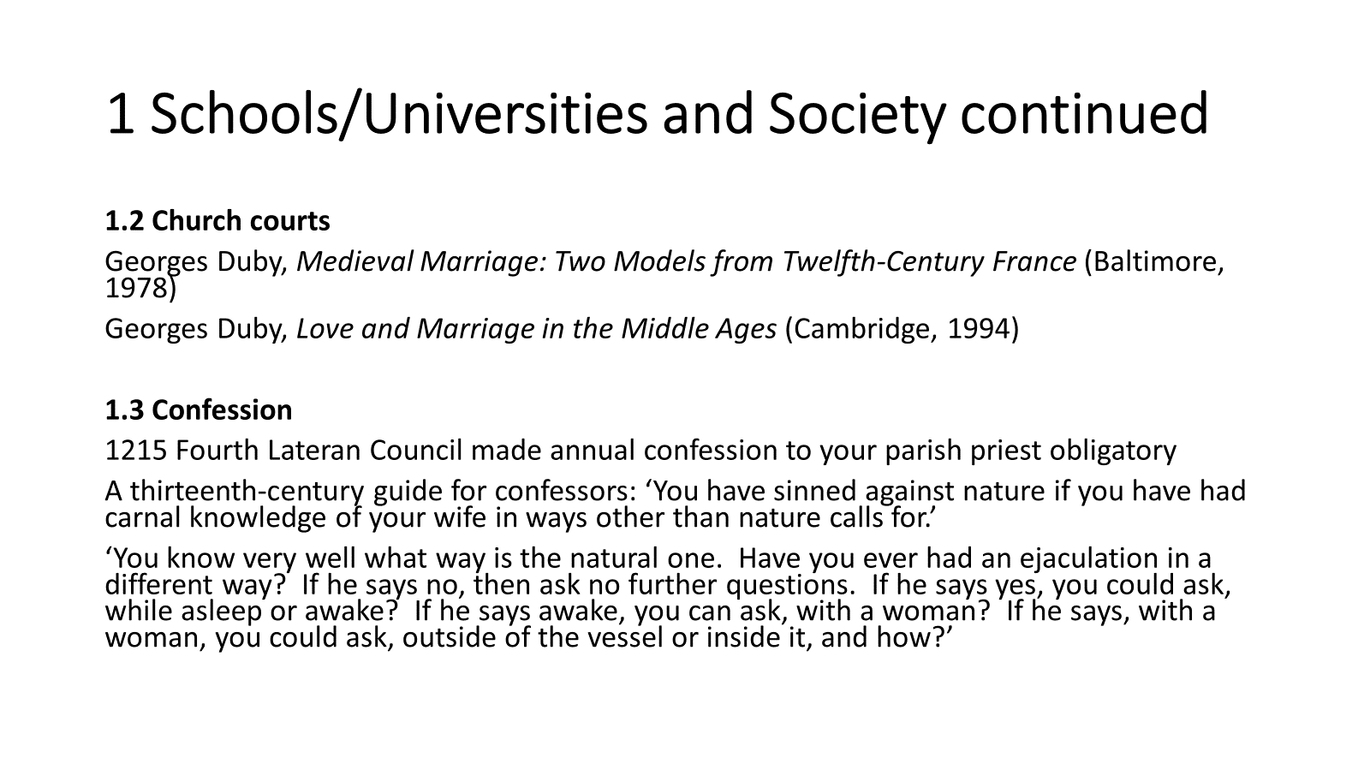
Were people outside the schools & unis familiar w/the views of learned men on sex & marriage?
How were the views of learned men communicated?
lewd ⛪ carvings
Shock & disgust 🧍 through carvings displaying their genitalila/ mak. lewd gestures
Many of these put up in C12
Intially historians thought they were pagan survivals/ put up against ⛪ wishes
BUT par elaborate programmes sculpture designed to convey theological messages → had to be done w/approval clergy
Even if embarrased clergy had moved them to more obscure parts ⛪, originally central
Spread amongst pilgrimage sites europe
ironically, those who condemned sex condoned sexually explicit imagery to 🎭 🔗 devil & sin
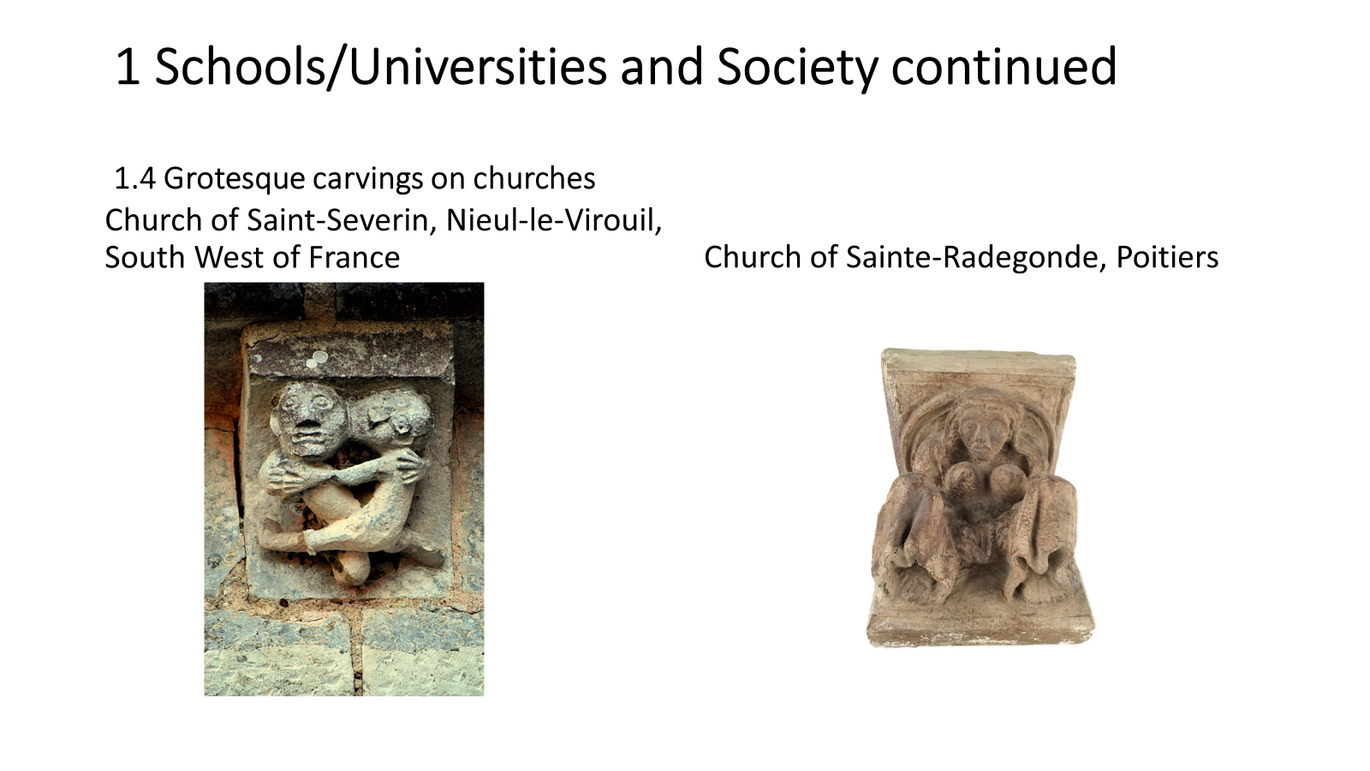
Bayeux Tapestry
Janina Ramirez
Should be described as a ‘mistresspiece’ rather than masterpiece, ∴ created by team ♀ embroidered.
Sexism consid. its creators
Yet nobody would thihnk of discussing Starry Night w/o mentioning artist Van Gogh/ Mona Lisa w/o extensive investig. into life & times of Leo da Vinci
V/few discussions Bayeux Tapestry think ab. women who made it
Astonishing work of art, full of drama, symbolism, depictions warfare, daily life, court politics & emotive cast C11 individuals
(C11) ♀ artists outperformed 👨 in field embrodiery.
women have excelled at neeedlework & textile production since antiquity
Whilst 3 artistic grades of painting, sculpture & architecture had been dominated by men, creation fabrics (<- spinning wool -> decorating textiles) largely realm of women (R23).
Some women canonised for their embrodiery (P142)
Whilst is macho affair (only 3 women depicted in main narrative tapestry), recogn. female expereinces
female figure clasps hand young boy as building burns behind them. (woman & child running a. <- burning building) She reaches out her other hand tow. 1 men holding torch, as if calling to him.
Scene prob. represents acts raiding & destruction conducted by Normans along English coast when they plundered surrounding villages for food & supplies to supp. army.
In this case the woman & child are victims of war, & this tragic scene shows vulnerability & suffering that so many across England experienced in face invasion.
generalised repres. women & children who suffered after invasion
decorative margins
where creativity & imagination female embroiders most evid.
graphic designs on og tapestry stiched by nuns
4 men w/erections + 1 flaccid penis visible in margin where an indiv. being stripped of his chain mail (R51)
sev. sexually explicit scenes
Has been sugg. Edith may have been brains behind embroidery itself (R79)
What challenges did nuns face?
Faced challenges due to strict monastic regulations.
2nd Latern Council 11389 -> indep. women in churhc problematic; enforced sep. monastic communitites -> strict enclosure nuns (R33)
Clampdown on monastic preaching
Julian of Norwich
📚 Revelations of Divine 💘
What does this reveal ab. women & broader picture MA?
Janina Ramirez
Describes sufferings JC & repeatedly asserts God’s motherly💘God for his creation lies @ core of all existence.
Famous phrase ‘all shall be well, all shall be well & all manner of things shall be well’ - not true piece consolation but rather meaningful & consid. statem. divine intent
Refered to JC as 💘, suggested sin was ‘behovely’ (nec.), & she saw god as entirely forgiving, no matter what a person did dur. their lives (R19)
Would have kept her writings secret whilst inside her anchoress cell
fact her works survive are evid. female solidarity
Women chose alternative way life - one that delib. removed them <- established female realms kitchen, nurseru & bedchamber.
Thrived in monastereis & bookshops, stepping aw. <- domestic interiors & embrac. new challenges.
That they could do this is testament to how formidable they were as individuals + that medieval period perhaps more accommodating than we think.
not ‘dark’ age, a time of barbarians’: to be ‘medieval’ is short-hand for backwards, superstititious, reactionary, volatile
should create as authentic picture as poss. of these women & time in which they lived
Hildegard von Bingen
feminist icon? view of women
(beg. career) berates her femininity
Janina Ramirez
(1st recorded letter, addressed to Bernard of Ckaurvayx (preacher & mentor pope, 1 most influential men C12) heard how she was ‘miserable & more than miserable in my womanly existence’
(1st major work Svivias) Contin. to emphas. 👩 frailty & passivity
perpetuated Genesis account how 1st woman created out of Adam
Like Eve, Hildegard remained ‘in the fragility of the weaker rib but filled w/mystical inspiration’
in line thinking male scholars
Hildegard von Bingen
feminist icon? view of women
Why might she have been so negative?
Janina Ramirez
Need to self-censor
In presenting these trad. views gender difference, playing to societal norm, creating unconfrontational space in which her voice could be heard.
(start her careerO Had to describe her experiences, emotions & ideas in ways acceptable to male aud. would scrutinise the,.
-> as grew in confid. & reputation, no. references to her weaknesses as woman decreased (detailed p.192-3)
Hildegard von Bingen
feminist icon? view of women
invested female imagery w/much more postive value - elevated women more than men
emphas. women’s equality w/men
theological emphasis women
Positioned men & women not in opposition to one anoth., but as displaying wide range characteristics depend. on their natures (e.g. their bodies → later) → marital affection
Her theology emphas. importance female figures Ecclesia, Synagoga, Love, Wisdom, Eve & V, as foundaitons both spiritual & univ.
Eve
temptressbut companion, future human race. Granted her dignity ♂ intellectuals never contemplatedLike♂ scholalrs, believed all women 👩 exalted & redeemed by VMRather than God the Father as dominating, intimidating male presence, Hildegard makes the divine feminne, a liv., omnipresent energy subsumed within nat. world.
Priesthood male BUT all aspects RCC (even JC himself) only exist through female
Nat. world harmonised through female figures of Divine Love & Wisdom.
RCC as caring 🤱 for its children.
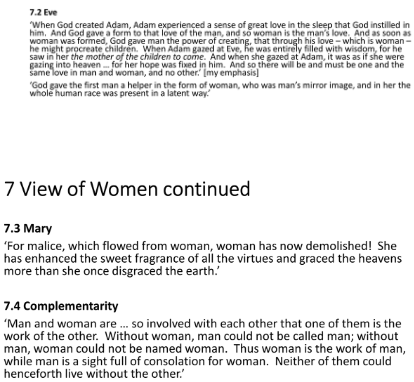
Hildegard von Bingen
dichotomic views sexuality
men have more passion than women in sex
idealised chastity (visions virgins in heaven)
sex for purpose procreation
Her writings never overstepped bounds contemp. debate & her writings endorsed by Pope
BUT…
Unlike many of her contemporaries…
desc. it w/o condemnation
partic. concerned w/female sexuality
Advocated drinking beer (quotes p.189)
Interested in gynecological and sexual well-being.
Opposed contemp. male authors consis. reinforced idea women more lustful men.
Described female orgasm and believed in its importance.
(1150) Prov. 1st nown description what female orgasm looked like (p189)
Drew attention to differences bet. male & female bodies to stress they were unique, rather than one being inferior to other
Positive view human sexuality, seeing in them a necessity & stressing better for alm. all people’s health to be sexually active than not
1st sexual enounter bet. A&E sweet lovemak.- since Fall, had -> increasingly hot & greedy
Even argued a person’s temperment affected by feelings parents dur. intercourse - the more loving & pleasurable the sexual encounter, the happier the child
perhaps (like male scholars yesterday), not topic on which she found it easy to be consistent - fits in w/inconsistency rest scholarly trad.
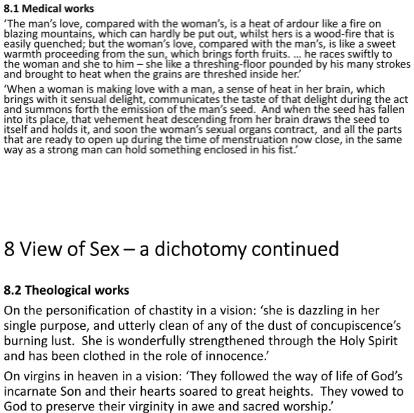
Hildegard von Bingen
Why is she significant in terms of her output?
Wrote 3 major theological works, 1st morality play, 2 scientific treatises, over 300 letters, and a large body of music.
Invented her own language, Lingua Ignota.
Significance
Polymath comparable to Leonardo da Vinci.
Enormous output -> her rep. rivalled by juut handful individuals: perhaps only polymath Leo de vinci can compare to her - but he rarely even completed his projects; she did
Among pan-European intellectual elite.
Broke traditional gender roles, rising to fame in ways many men of her time couldn't.
Hildegard von Bingen
1 1st female visionaries
Janina Ramirez
Others like Theresa of Avila rose to prominence mystics C14 - but female visionaries C12 not common.
Hildegard von Bingen
contributions to medicine
Janina Ramirez
Considered founder nat. sciences in Germany.
Known for herbal remedies.
Displays unique understand. bodily needs 👩
Some of her suggestions are not what we might expect of a nun. e.g. lists plants can be ingested to bring ab. abortion - detailed below p.188
Even today, many would consid. this radical
Undermined establishd misogynistic views tow. menstruation, stressing instead it is part nat. flow blood in all humans goverend by moon.
Hildegard von Bingen
advised & chastised 🧍 in power
Weak & submissive. V/prep. to take on ♂ auth → bully monks into submission.
Forceful in her own defence + worked to protect her community of sisters and bring about global change.
illness
been claimed she used her health complaints to manip. situations, as reg. -> ill when challenged by others (e.g. when abbot of Disibodenberg refused to give her monastery of her own)
later conceded only because was told Hilgegard (at this point completely paralysed) could die
letters
Wanted to defend whole ✝ soc., defending anyone (e.g. allowed excommunicated woman to be buried in her graveyard → issue resolvesd event. in her favour)
see 2nd letter for another example
German abbess writing to king of england, telling him to submit to church
even blunter to German Emperor Frederick Barbarossa
these 2 hadn’t asked for her opinion… she just wrote it anyway
powerful player on internat. stage, like Bernard clairvaux
no constitutonal pos. that gave her auth. over people
yet certainly had power auth.
YET Bernard = man; she = woman… how did she do it?
Her contemporaries accepted God spoke through her through visions → prophet → allowed her to address popes & kings so aggressively.
Speak as a woman; it was God who spoke through herThreaten to subvert♂order
not ecstatic visions… not trances (doesn’t lose consciousn.) but doesn’t physically see it either
→ mirgraine OR did she consciously choose this as stregafy to exercise power & auth.?
was she aware it was secret of her power?
imposs. to know
but we can look at her work to discover her attitudes on various issues → consid. extent to which she accepted views sholars
mystic trad. giving women more of a voice
use art & music
Mind so overstimulated & full of og ideas
Used art & 🎵 to express passion, feeling & sensosry experiences. Used all means avail. through her senses to explore her understanding existence.
Been tutored in uni/ trained in lib. arts as ♂ scholar would’ve been. But had intellect & skills to express her ideas in distinctive ways allowed her to communicate effectively.
e.g. created own lang. & alphabet
W/o rhetoric & training of male writers, she developed her own forms of creative expression which sprund <- her femininity & her visions
Her music unlike anyth. else that survives <- medieval period - detailed p.202
affects hearer to arouse their soul to heafuln. God
Vagina 🥚 🖼
3rd illustration in Book One of Scivias (finished around 1147)
vision quoted p.201
explains vision as representation univ. in form egg. 🔗 her ideas feminine within the divine, since only the female produces eggs -> univ. made <- woman.
Male & female both nec. for creation.
Created atmosphere empowerment amongst her nuns at Rupertsberg
Her music celeb. power & beauty of women like VM.
Her songs are unusual in how much attention they pay to VM (detailed p.197), empowering women
Wrote back, claim. women deserved to look beautifl → flouting monastic trad.
agency of increasing female agency & promoting history Rhineland
female solitude (think seminar courtly love)
p.198 deets on how singing contrib. to this
flouted monastic rules & proudly did so, writing back & going on her own preaching tours
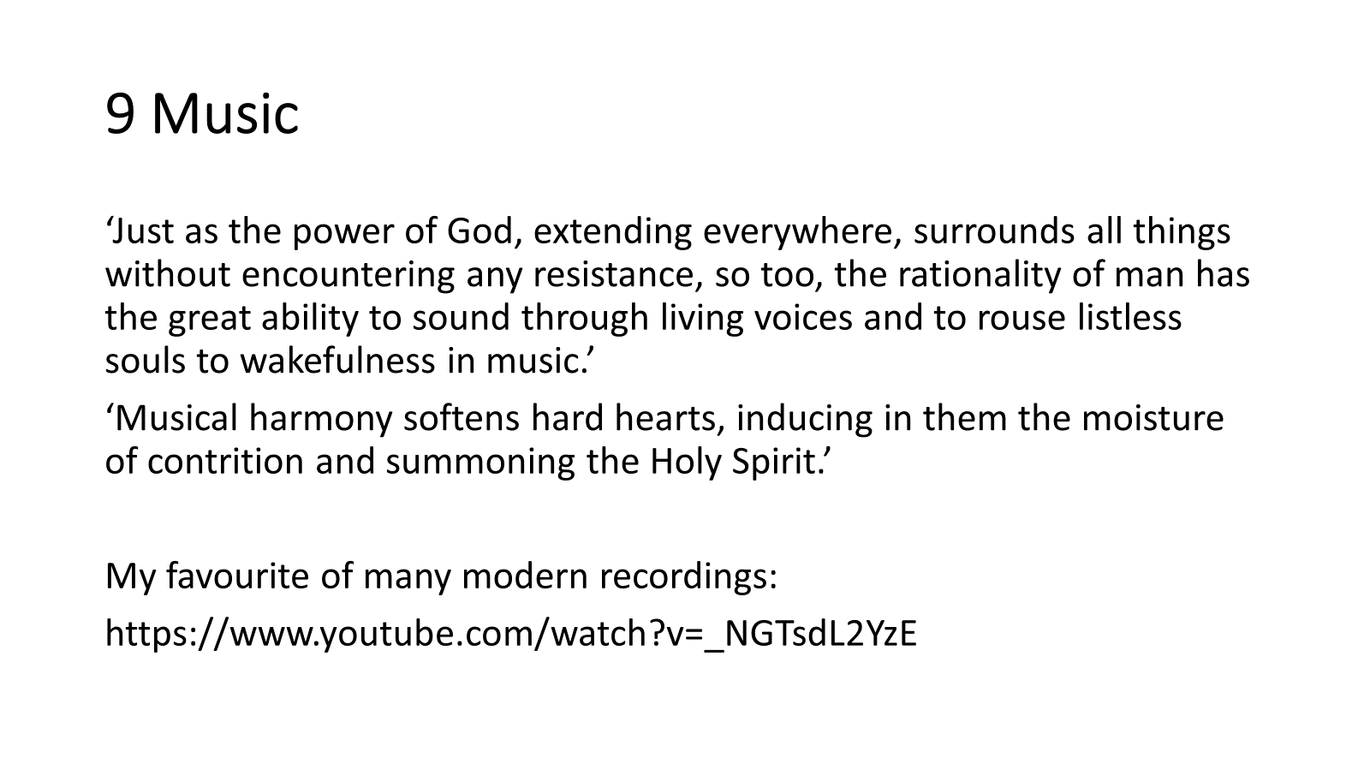
legacy
Yet still exper. misogny (p.193)
Meconi does wonderful justice to Hildegard whom she says ‘was by no means the only learned or creative woman of her time … but no other woman was so consistently productive across as many realms’ (p.48).
Broke the mould: part of a pan-European intellectual elite that included men & women, & was supp. by those around her to rise to fame in a way many men of her time could only have dreamt of.
Her public works put concerns women in front leading male power players of the time & her own example would’ve proved inspirational to others that followed her. As her rep. grew, so did her worldly influence.
papal power: achieved monastery thanks to backing pope (Eugenius III) - p.193
had broken into male-dominated world theology & had papal supp. to do so
W/pope’s backing for Scivias, Hilegard -> internat. superstar
og & trailblazer -> increasing taste for female mystics spread throughout Europe
other women like Julian of Norwich
brilliant woman in her own right (p.206-7), showing more than 1 C12 wwoman chall. status quo (R91)
Hildegard proved women could learn, write, create & carve out pos. power for themselves, inspir. a devotinal following.
PS letters 207-8 - both men & women
loved & celebrated
summary of her being amazing p.209
Perehaps helps our modern self-esteem to view MA as misogynistic (p.221)
